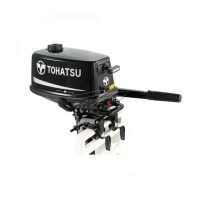INSTALLATION
Î
£Î
• Before beginning the running test,
check that the boat with maximum
capacity loading floats on the
water in a proper attitude. Check
the position of water surface on
the driveshaft housing. If the water
surface is near the bottom cowling,
in high waves, water may enter the
engine cylinders.
• Incorrect outboard motor mounting
height or existence of underwater
object(s), such as hull bottom
design, bottom surface conditions
or underwater accessories, can
cause water spray possibly reaching
the engine through an opening of
the bottom cowling during cruising.
Exposing the engine to such
conditions for extended periods can
lead to severe engine damage.
!
#!54)/.
Mounting bolts should be installed with
the bolt head at inside surface of the
transom. Mounting bolts installed with
the threaded end at the inside surface of
the transom can cause personal injury.
!
#!54)/.
!
7!2.).'
• Mounting the outboard motor
without following this manual can
lead to unsafe conditions such as
poor maneuverability, lack of control
or fire.
• Loose clamp screws and/or mounting
bolts can lead to the release or
displacement of the outboard motor,
possibly resulting in lost of control
and/or serious personal injury. Be
sure that fasteners are tightened to
the specified torque (30 Nm (3.0kgf)
13ft·lb). Check the fasteners for
tightness from time to time.
• Be sure to use outboard mounting
fasteners included in the outboard
motor package or their equivalents
in terms of size, material, quality
and strength.
Tighten fasteners to the specified
torque (30 Nm (3.0kgf) 13ft·lb). Test
cruise to check if fasteners are
tightened securely.
• Outboard motor mounting must
be performed by trained service
person(s) using lift or hoist with
sufficient capacity.

